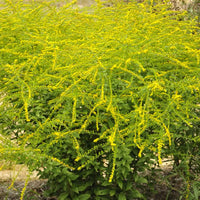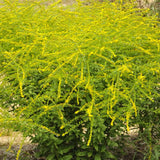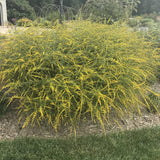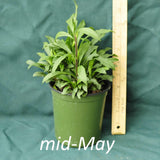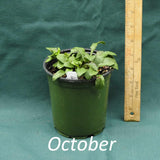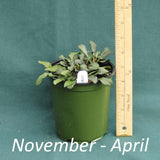Here’s how it looks today, getting close to blooming.
Today, I got out my tools for heavy duty weeding. I start with the fancy hoe. I can’t remember what it’s called, but someone recommended it and I got it. You push it parallel to the ground just underneath the weed, and when you pull it back the weed is uprooted. It works really well and easily.
After I get the weeds uprooted, I use the pronged tool to rake them into a pile and pull up anything still hanging on to the earth. And with the broken muck rake I “muck” the pile and carry it to my brush pile, which is not too far away from these beds.
BUT, I decided to ask husband to repair an old haybarrow that’s been set aside for many months.Walking back and forth is taking too much time. He instead ordered my dream garden cart for me, which I’m very eager to get and use. I’ll show it off when it arrives.
Meanwhile, here’s my tool set for serious weeding:
I knocked out the entire fence line in less than half an hour, and transplanted goldenrod down about half of it. I’ll do the rest of the transplanting tomorrow.
The weeding was so easy using the tools I could hardly stop myself, and ended up doing about half the bed. I really could have gone on much longer but online family gaming awaited, so I called it a day!
On the other side of the driveway I took a shot of the larger bed. The one I was working in was too bright to get a good shot. I’ll do it another day.
I still need to trim back the remaining daffodils to clear the way for the asters coming in beneath.
More info on baptisia alba:
Baptisia alba
Baptisia alba (L.) Vent.
White Wild Indigo, White Baptisia
Fabaceae (Pea Family)
Synonym(s):
USDA Symbol: BAAL
USDA Native Status: L48 (N)
This 2-4 ft., mound-shaped perennial holds its white, pea-like flowers in erect clusters. Velvety, trifoliate leaves turn from bluish-gray to black in the fall. A bushy perennial with smooth leaves and white or cream-colored pea flowers in stiffly erect clusters; stem covered with whitish bloom. Clusters of large, black seedpods often remain attached to the naked winter stems.
This showy legume, long known as B. leucantha but now as B. alba, often stands out above surrounding prairie grasses. Many species of this genus contain a blue dye that resembles indigo and becomes noticeable in autumn as the plants dry out and blacken. Large-bracted Wild Indigo (B. bracteata var. leucophaea) has two large stipules at the base of 3-parted leaves, giving the effect of five leaflets rather than three.











